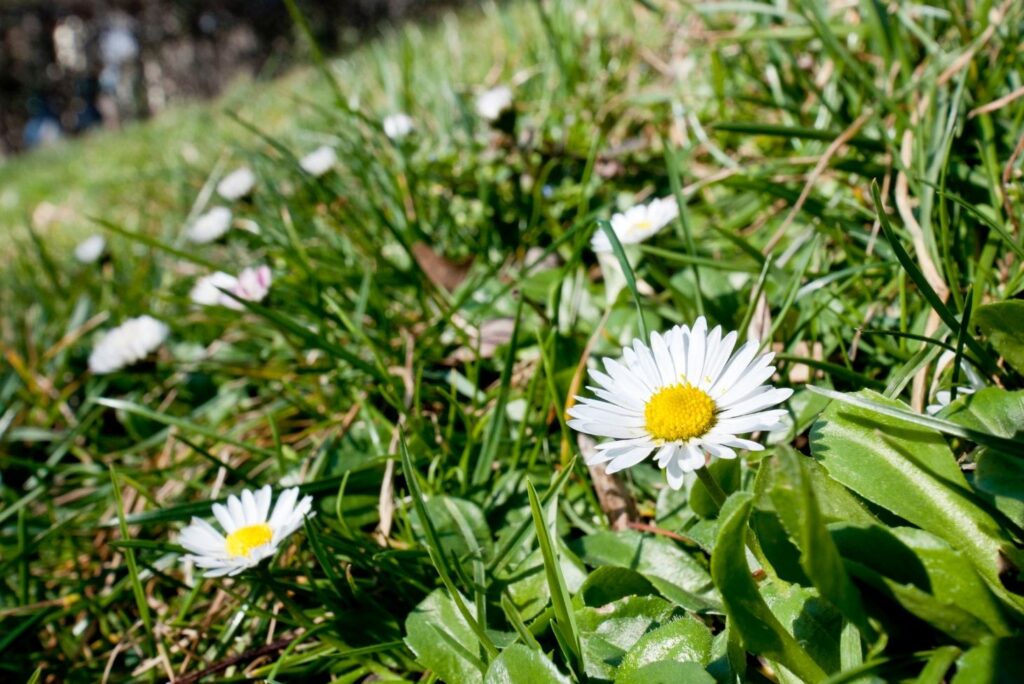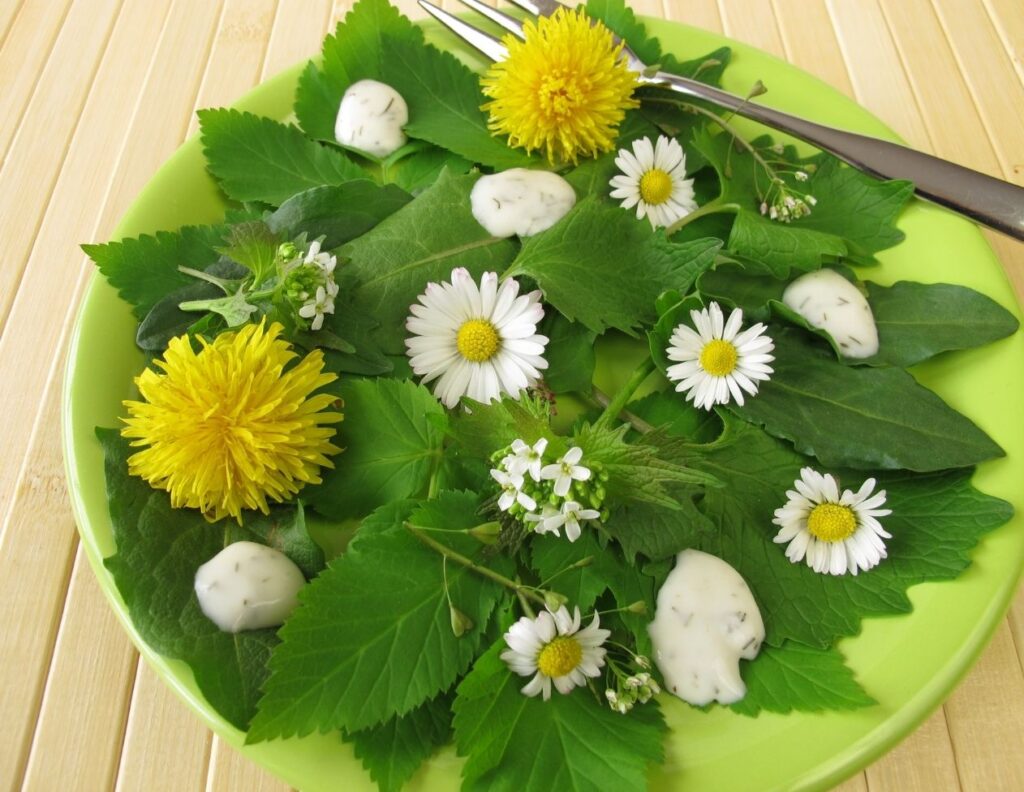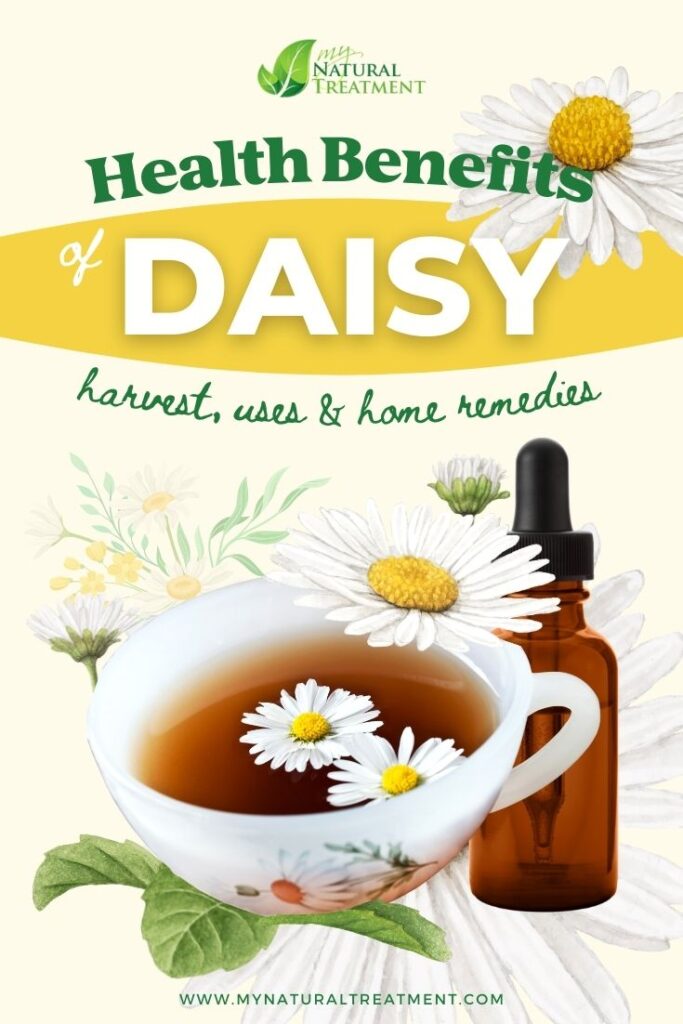If you want to learn about the health benefits of daisy, the medicinal uses of daisy, and how to make daisy salad and daisy tincture, continue reading this article. But first.
Daisy (Bellis perennis), or common daisy is one of the lovely spring flowers, and although very common and widely spread, its medicinal uses are most likely unknown by the general majority. Indeed, there are tremendous health benefits of daisy, because this simple wildflower has important medicinal uses, it is edible and by the end of this article you will know how to make the healing daisy salad, how to make daisy tincture, and the most important health benefits of daisy, together with remedies. So let’s get to it.

In This Article You Will Find:
How to Harvest Daisies
The common daisy is native to Europe, Northern Africa, and western Asia, but is commonly found as an invasive plant in North America, South America, and New Zealand. Due to their small size, harvesting daisies requires a lot of patience, but this is worth it. You will rarely find quality wild daisy tea on the market.
Pick and dry the flowers by hand in sunny weather, when they are in full bloom. Spread them on a piece of paper or a linen tablecloth to dry naturally. Drying is done in the shade, in a thin layer, in well-ventilated places. When they are fully dried, store the daisies in paper bags or in a glass jar for later use. The shelf life of dried daisies is two years, and if you powder them up, you can use them in three weeks’ time.
Health Benefits of Daisy
Daisies are part of the spring detox plants family. Their flowers and leaves are very cleansing for the stomach, liver, and intestines. The flowers and young leaves have diuretic, antispasmodic, anti-inflammatory, astringent, expectorant, antipyretic, vulnerary, ophthalmic, and homeostatic effects.
In Romanian folk medicine, these small white spring flowers, with a tint of red on the edges have been praised for their detoxifying properties, but also for their health benefits for kidneys and lung problems and their antitumor properties. Fresh or dried daisies were used in treating throat and chest afflictions, from simple colds to asthma and even lung or breast cancers. Thus, the main health benefits of daisy are:
- headaches and migraines
- chronic liver problems
- gallbladder ailments
- kidney failure and kidney stone
- bronchitis, asthma, cough
- breast injuries and breast cancer
- lung cancer
- poor digestion
- rheumatic pain
- miscarriage traumas
- uterus wounds
- wound healing
Daisies are a real elixir for meat lovers and those who have a diet based on junk, fried foods, or foods with additives, due to their strong purifying effect. Now that you know what are the health benefits of daisy, here is how to harvest and use daisies.

Which Daisy Is Medicinal?
The daisy used for medicinal purposes is the Bellis perennis variety. You can use it in four ways, as a salad, as an infusion, as a powder (using dry flowers), and as a tincture. There are also homeopathic remedies that use daisy flowers, under their scientific denomination Bellis perennis. Here is how to make simple medicine with daisies, and use them for their therapeutic uses in home remedies.
1. How to Make Daisy Infusion
Daisy infusion stimulates the activity of the kidneys, increases the urine quantity, stimulates perspiration, and promotes the elimination of toxins through the digestive tract (has a bitter tonic effect). To make daisy tea, use only fresh-picked flowers (without stems and leaves). If you don’t have fresh flowers, dried ones can also be used. Here is how to make daisy infusion.
- Finely chop a handful of fresh daisies and soak them in half a liter of room temperature water (2 cups) for 4-5 hours, then strain.
- Set aside and scald the flowers this time in another half liter of boiling water.
- Cover and allow to infuse until it has cooled down.
In the end, combine the two infusions (the cold brew and the hot infusion), and you will get around one liter of tea (4 cups). For its beneficial action, daisy infusion is drunk in three reps throughout the day, on an empty stomach.

2. How to Make Daisy Salad
Daisy salad is made using the fresh leaves and flowers of freshly picked daisies and is one of the most cleansing wildflower salads you can make. Wash well two handfuls of daisies, finely chop them and then put them in a bowl. Season with chopped dill, a little lemon juice, a few splashes of plain or spring water, and a teaspoon of vegetable oil. Leave aside for 15 minutes and have this detox salad on an empty stomach. To enjoy the healing virtues of the daisy salad, have a bowl of this salad before each meal of the day for seven days in a row.
You can also add daisy flowers to other salads, including fruit salads or even soups (but only after it has cooled a bit). It is recommended for those suffering from constipation, people suffering from water retention or those who tend to accumulate many toxins in the body.

3. How to Make Daisy Tincture
Daisy tincture is a simple medicine anyone can make at home from fresh daisies. Fill up a mason jar with finely chopped fresh daisy flowers, but don’t push them down, leave them as they are. Fill the rest of the jar with 80 degrees of fine quality alcohol, and give it a good stir. Seal the jar and leave to macerate in a cool place for 3 weeks, then strain and pour the tincture in smaller amber glass bottles with droppers.
7 Natural Remedies with Daisies
1. Migraines
Migraines caused by kidney or gallbladder problems (that cause excruciating headaches) or migraines caused by either concussions or intense stress can be relieved by eating daisy salad. Indeed, headaches and migraines can be relieved by eating fresh daisy salad, in a two-week cure. Drink combined daisy infusion alongside, for two weeks. Especially if your migraine is caused by severe dehydration, you can have 2-3 cups of daisy flowers infusion every day.
If the migraine is caused by gallbladder problems, add 50 drops of St. John’s wort tincture in each cup of daisy infusion. Daisy tincture can also have very good results in treating headaches. The recommended dose is one teaspoon in 100 ml of water (half a glass), three to four times a day. In conclusion, you can either opt for the combined infusion or the daisy tincture in combination with the fresh daisy salad.
2. Bronchitis, Asthma, and Cough
The abovementioned fresh daisy flower salad is also a great natural remedy for bronchitis, asthma, and lung problems in general. The secret is to chew it down slowly so that it can easily release all the healing juices. Another way to use fresh daisies for bronchitis is to chop them, mix them with honey are take a tablespoon every few hours. This simple remedy helps in treating infections in the throat and bronchi. For asthma, in particular, you can also use daisy tincture – 1 teaspoon three times a day. Add a drop of food-grade peppermint oil to each dose of daisy tincture to boost its pain-relieving properties.

3. Lung and Breast Cancer
One of the less-known health benefits of daisy is that in powdered form, it can help tremendously in lung cancer. To make the powder, grind dried daisy flowers with an electric coffee grinder, and have 4 teaspoons a day, on an empty stomach. This is an excellent adjunct remedy for lung cancer.
More so, one of the top health benefits of daisy is its property to attenuate and even participate in curing breast cancer. Again, the powdered daisy flower is the most potent form, alongside other medicinal herbs. To make this herbal blend, mix:
- 4 parts daisy flowers (Bellis perennis)
- 4 parts comfrey root (Symphytum officinale)
- 2 parts of butterbur leaves and flowers (Petasites hybridus)
- 2 parts purple loosestrife (Lythrum salicaria)
- 2 parts mistletoe (Viscum album) – ideally grown on apple or fir trees.
- 1 part birthwort (Aristolochia clematitis)
Finely ground the herbs in a coffee grinding machine, until you obtain a fine powder. The recommended dose is two teaspoons of this herbal blend powder four times a day for 12-18 months. Please consult with a physician or a naturopath before following any herbal treatments.
4. Hepatitis and Cirrhosis
Fresh daisy flowers chewed on an empty stomach have an extraordinary draining effect on the liver. Chew a handful of fresh daisy flowers a day, before meals, for seven days in a row. You can also have the daisy salad instead, but this time add daisy leaves and flowers in equal proportions. In combination with artichoke and juniper, dried daisy flowers have a beneficial effect on cirrhosis.
The daisy salad cure is also a simple remedy for poor digestion, bloating, and constipation. This simple salad has digestive tonic effects, drains the bile, stimulates the “lazy” stomach, and prevents bloating.
5. Chronic Kidney Failure
It’s still a mystery how daisy tea acts on the kidneys, but practical results show that daisies stimulate the filtering capacity of the kidneys, regardless of whether it is affected by an infection, an autoimmune process, or diabetes. Indeed, this is one of the main health benefits of daisy.
For chronic kidney failure, you can drink one liter of combined daisy infusion a day, for 12 days in a row, on an empty stomach, morning, afternoon, and evening. Drink the tea at room temperature and sweeten it with a little honey to taste. The purifying effect of daisy infusion is boosted considerably if you add in it two or three dandelions (roots and aerial part). This daisy infusion cure is also effective in food poisoning.
Daisy infusion is also effective in kidney stones caused by high levels of uric acid. For this, use the same combined daisy infusion recipe, but add to it a handful of fresh birch leaves or a teaspoon of birch buds. Follow this cure for 21 days, in which you drink 1.5 to 2 liters (6 cups to 8 cups) of tea per day, on an empty stomach, split into two large portions (morning and evening).

6. Rheumatism
Rheumatic pain outbreaks that show up in the spring can be attenuated if you follow a two-week cure with daisy infusion, stinging nettle, and chervil (one handful of each prepared according to the combined infusion recipe above). This herbal cure not only prevents rheumatism but also relieves the already inflamed joints, rejuvenates the body, and restores its mobility.
7. Women’s Health
Daisies are also recommended for women’s health problems, especially for local injuries to the chest or uterus (administered in homeopathic dilutions), heavy menstruation, partially unhealed soul trauma after miscarriages, and postpartum bleeding, or for overcoming a traumatic event related to childbirth. For these problems, daisy is rarely used as an infusion, but as the homeopathic remedy called Bellis perennis mother tincture. The recommended dose is 5 drops in the evening, between 1 and 3 menstrual cycles.
Natural Skincare with Daisies
In addition to the health benefits of daisy already mentioned, this lovely spring flower can also be used in natural skincare, especially for puffy eyes, brown spots, and chapped lips. Here is how to use daisies for this.
- Puffy, swollen eyes and reddish eyelids – apply daisy water compresses over the eyes (to make daisy water soak 2 tablespoons of finely chopped daisy flowers in a cup of water for 12);
- Cracked lips with ulcerations – chew a few daisy leaves to bring out their juices, then anoint the lips with them. Or make your own salve with the juice from fresh daisies.
- Brown spots – many of the skin’s pigmentation disorders disappear or fade on their own after flushing out the toxins from the body that caused them. For this, a 21-day cure with 1 l (4 cups) of daisy infusion, can work wonders. Enhance the healing effects of the daisy infusion by eating a predominantly raw diet (with 50-70% raw vegetables and fruits). Include daisy and dandelion leaves salad, carrots, celery leaves, radish, garlic, and green onions.
The Strength of The Wild Daisy
Common daisies look like tiny daisies, pitted in the early spring grass blades, making their way out into the warming sun rays. They are the bravest spring flowers, as they come out at the first breeze of warm wind and at the first sun rays in early springtime. Once they start to come to the light after a whole month, even under the winter snow, these apparently frail flowers can withstand everything in their way, as they come to renewal and purify all nature, including the human mind and body.
Daisy represents vulnerability at its peak, but this is just a facade because, behind the first impression, daisies are mighty and very powerful. The health benefits of daisy are tremendous, and this proves my point.
Read About The Health Uses of Other Spring Flowers:
Corydalis
Cowslip
Daffodil
Lily of the Valley
Sweet Violet
Snowdrop
If you’ve enjoyed learning about the main health benefits of daisy, please share this article so more people can use this information. Thank you for being here. Stay healthy, naturally!
Share on Pinterest ❤️


